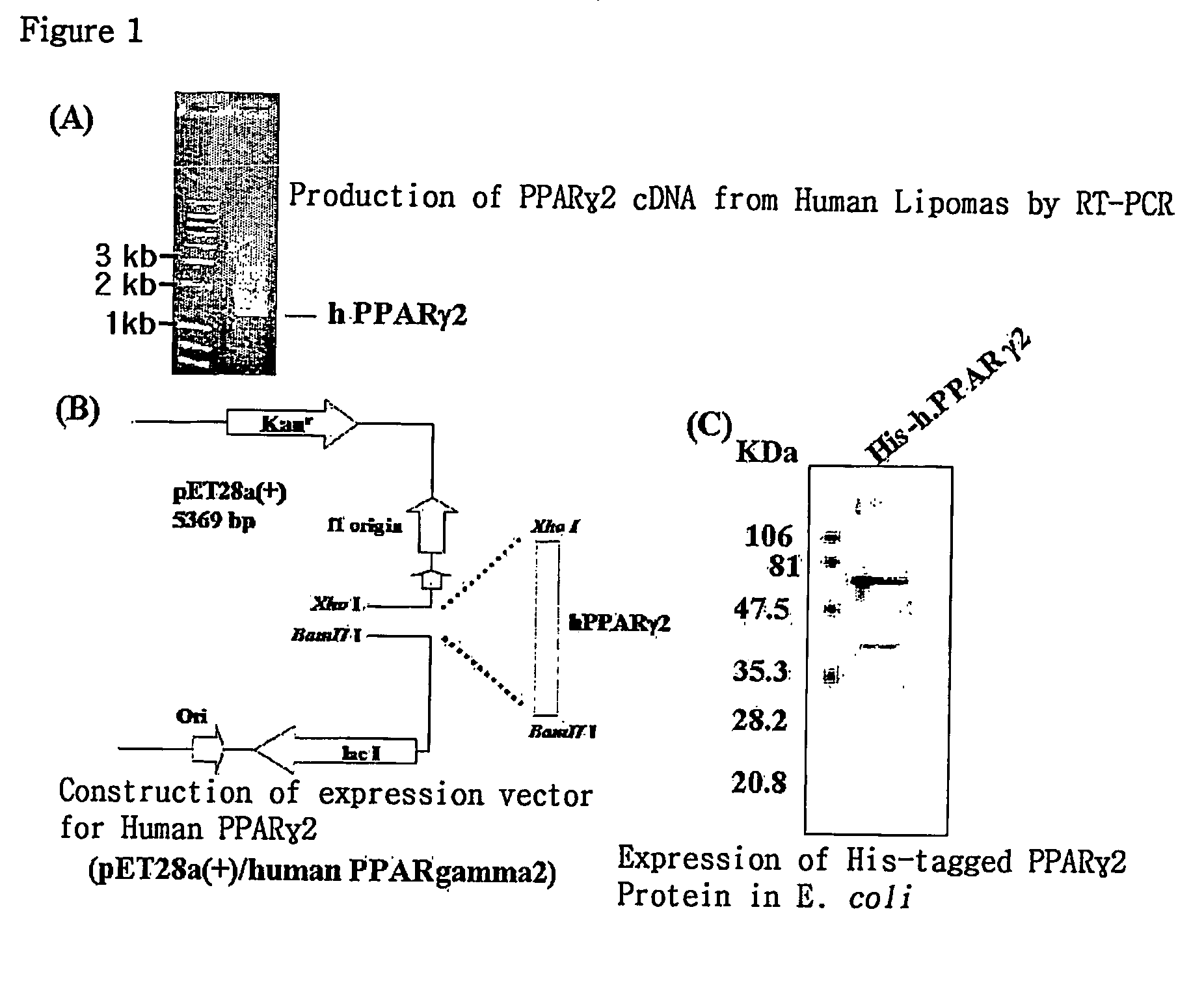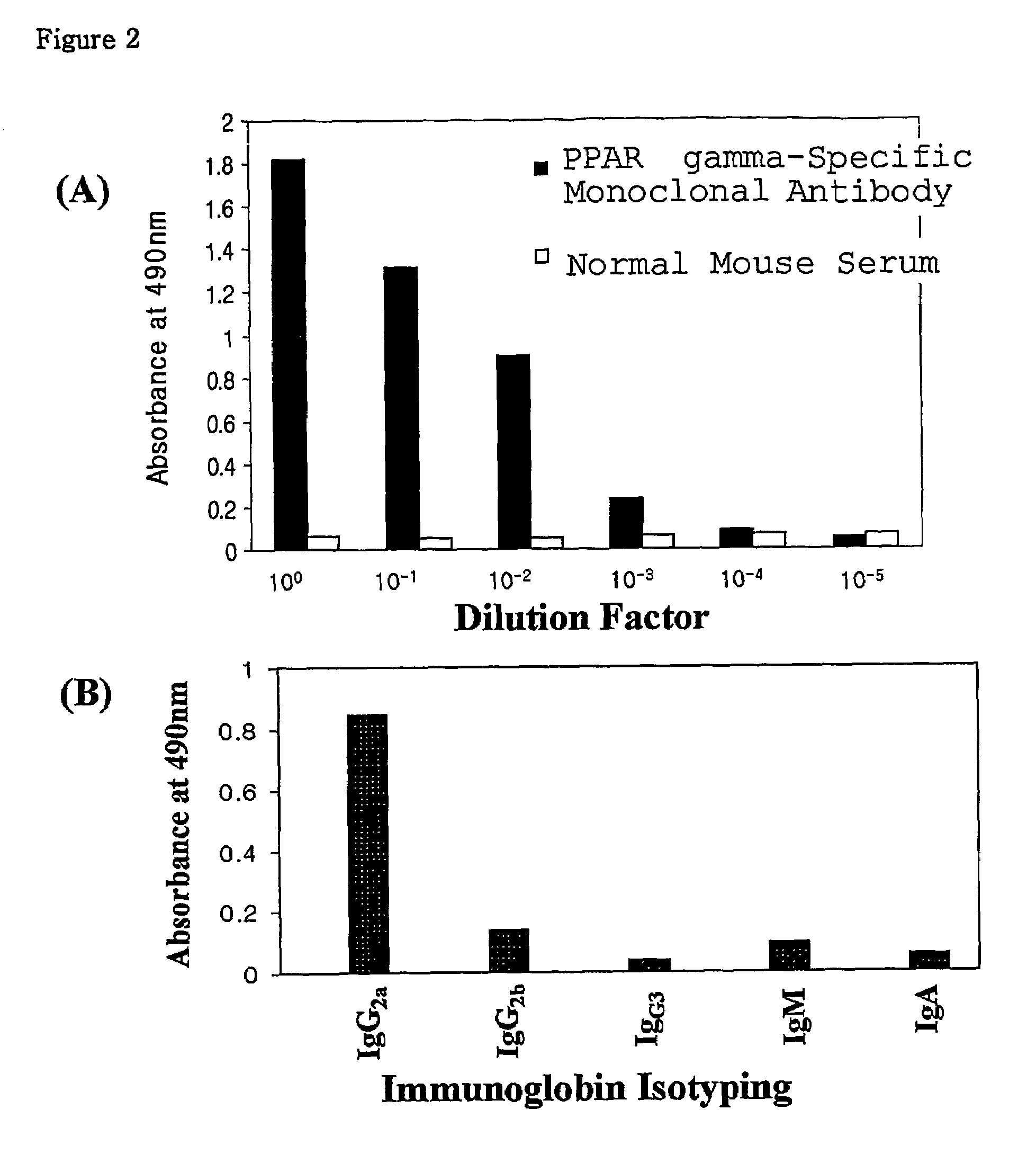Monoclonal antibody specific for PPAR gamma, hydridoma cell line producing the same, and method for detecting regulator related to diseases, including inflammation, cancer and metabolic diseases, using the same
a hybridoma cell line and ppar gamma technology, applied in the field of ppar gammaspecific monoclonal antibodies, can solve the problems of slow progression of ppar gamma, reduced glucose consumption, and ineffective ppar gamma against acute inflammation caused by leucocytes, and achieves precise and reliable results
- Summary
- Abstract
- Description
- Claims
- Application Information
AI Technical Summary
Benefits of technology
Problems solved by technology
Method used
Image
Examples
example 1
Preparation of Expression Vector Producing PPRA gamma Recombinant Protein, and Isolation and Purification of Recombinant Protein
[0074]To obtain a PPAR gamma recombinant protein, a human PPAR gamma2 cDNA gene was used. This gene was obtained by isolating mRNA from human lipoma and then amplifying it by reverse transcription-PCR. An expression vector pET28a (Novagen) was cleaved with BamH I and Xho I restriction enzymes, and the gene was ligated into the vector by lagase at 16° C. for 5 hours, thereby producing an expression vector having the PPAR gamma2 gene.
[0075]The expression vector pET28a, which can express a 6-histine-tagged PPAR gamma protein, was transformed in E. coli BL21(DE3), and then shake-cultured at 37° C. in LB medium containing 100 μg / ml kanamycin antibiotic. When the absorbance at 600 nm reached 0.4-0.6, the culture solution was added with 1 mM IPTG (isopropylthio-β-D-galactoside), and cultured overnight at 20° C., thereby inducing the expression of the gene. The res...
example 2
Isolation and Purification of GST-fused PPAR gamma2 and His-SRC-1 Recombinant Proteins
[0076]To produce a GST-PPAR gamma2 recombinant protein, there was used E. coli (pGEX4T-1 / PPARγ 2; KCTC 10190BP) which had been transformed with expression vector pGEX4T-1 (Pharmacia) cloned with the PPAR gamma2 gene of Example 1.
[0077]Under conditions of over-expression and efficient production of a recombinant protein, E. coli was cultured. The cultured E. coli was disrupted with ultrasonic waves, and centrifuged and the supernatant was collected. A soluble fraction of the supernatant was directly used.
[0078]Meanwhile, a SRC-1 protein was obtained as follows.
[0079]E. coli (pET28a / SRC-1; deposited on Feb. 22, 2002, in the Korean Type Tissue Collection (KCTC), located at Korea Research Institute of Bioscience and Biotechnology, #52, Oun-dong, Ysusong-ku, Taejon 305-333, Republic of Korea under accession number KCTC 10191BP) producing a His-tagged SRC-1 protein was cultured, disrupted with ultrasonic...
example 3
Mouse Immunization
[0080]To obtain an immunized mouse required for the production of a hybridoma cell line, His-PPAR gamma2 produced in Example 1 was dialyzed against phosphate solution for 12 hours, and the protein concentration was quantified to 25 μg / 100 μl by the Bradford method. Then, it was emulsified with an equal volume of a Freund's complete adjuvant and injected into the abdominal cavity of a Balb / c mouse (six weeks old). After two weeks, a His-PPAR gamma2 recombinant protein of the same amount as the first inoculation, which had been mixed with the same amount of a Freund's incomplete adjuvant, was injected to the mouse once a week. At 3 or 4 days after the last injection, a small amount of blood was collected from the mouse tail, and measured for antibody titer by enzyme-linked immunosorbent assay (ELISA). Before cell fusion, the mouse additionally received one injection.
PUM
| Property | Measurement | Unit |
|---|---|---|
| pH | aaaaa | aaaaa |
| molecular weight | aaaaa | aaaaa |
| concentration | aaaaa | aaaaa |
Abstract
Description
Claims
Application Information
 Login to View More
Login to View More - R&D
- Intellectual Property
- Life Sciences
- Materials
- Tech Scout
- Unparalleled Data Quality
- Higher Quality Content
- 60% Fewer Hallucinations
Browse by: Latest US Patents, China's latest patents, Technical Efficacy Thesaurus, Application Domain, Technology Topic, Popular Technical Reports.
© 2025 PatSnap. All rights reserved.Legal|Privacy policy|Modern Slavery Act Transparency Statement|Sitemap|About US| Contact US: help@patsnap.com



